The best World Cup final pictures
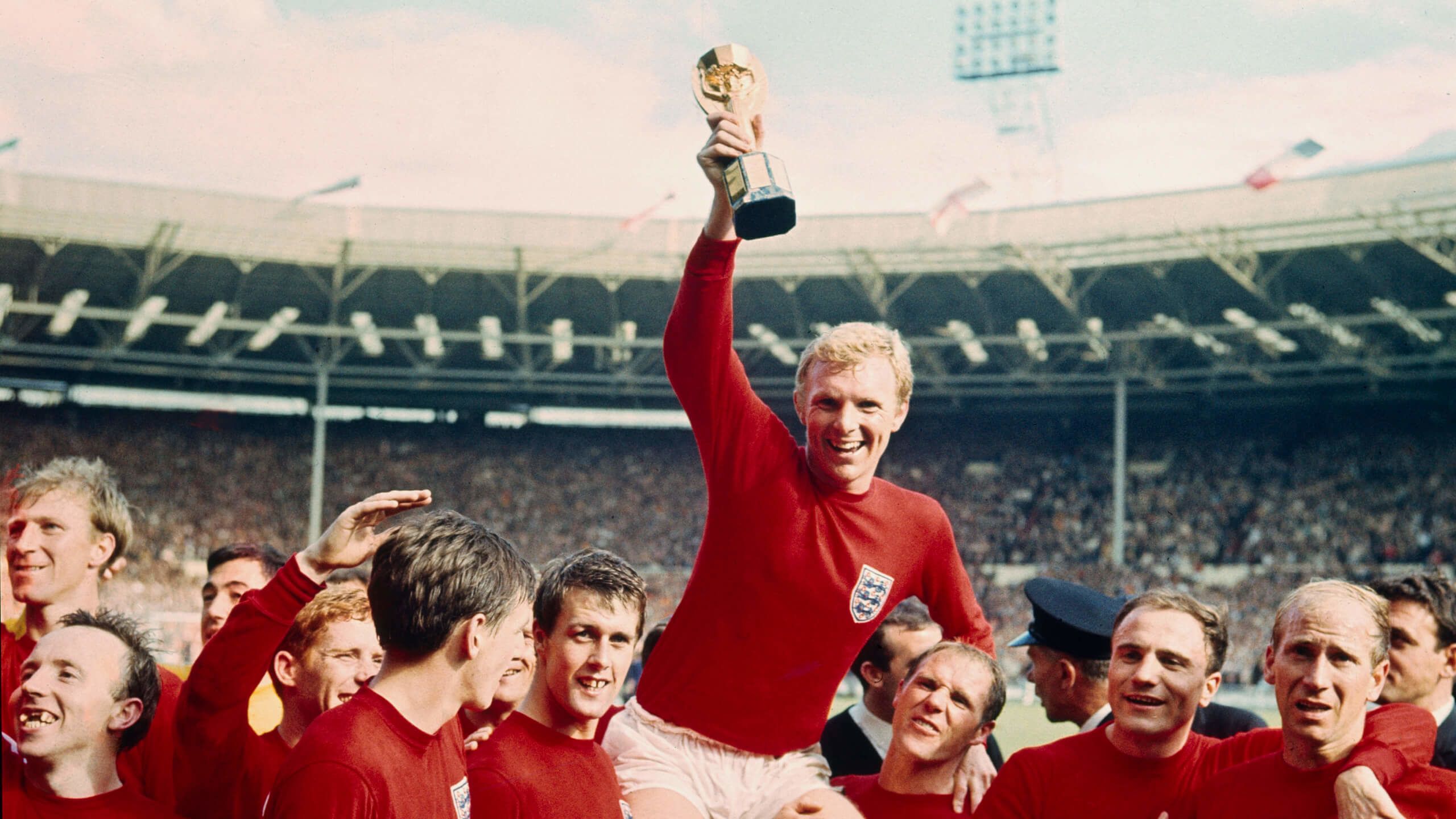
The eyes of the world will be on the Lusail Stadium in Qatar on Sunday when Argentina meet France in the final of the 2022 World Cup.
Thousands of camera lenses will be trained on the action, hoping to capture the moments that will be splashed across every newspaper in the days that follow and continue to evoke memories in the decades to come.
Over the past 92 years photographers have been in attendance at 21 finals to record what they witness - the colour, the excitement, the goals and the glamour. BBC Sport has partnered with Getty Images to bring you the best photos.
We begin on 30 June 1930 at the Estadio Centenario in Montevideo, Uruguay...
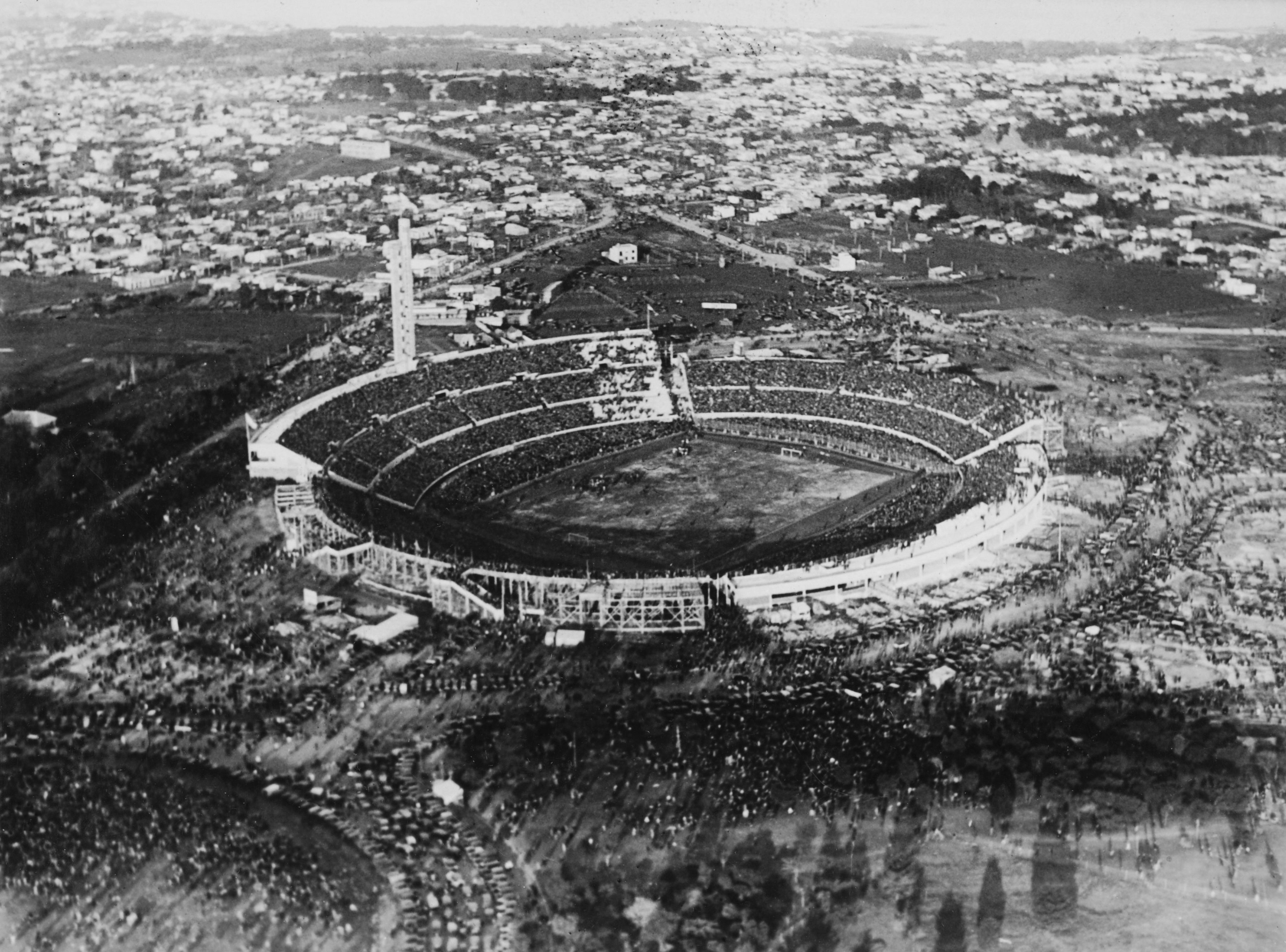
The 1930 showdown was between the hosts and Argentina in a rematch of the gold-medal game at the 1928 Olympics, which was won by Uruguay.
Thirteen teams took part in the inaugural tournament. Four arrived from Europe on the same boat, training on the top deck as they travelled.
Uruguay's Pablo Dorado scored the first World Cup final goal in the 12th minute of the contest (first picture below), but this was quickly cancelled out by Carlos Peucelle's fierce strike. Before the break, tournament top scorer Guillermo Stabile put Argentina ahead - his eighth goal of that World Cup.
Uruguay dominated the second half, though. Pedro Cea made it 2-2 before Santos Iriarte put them back into the lead.
With a minute to go, Hector Castro made sure of the win - and remains the only one-armed man to score in a World Cup final. His goal is the second photo below...
The win sparked huge celebrations on and off the pitch.

Members of the Uruguay team celebrate after winning the Jules Rimet trophy by beating rivals Argentina in the first World Cup final
Members of the Uruguay team celebrate after winning the Jules Rimet trophy by beating rivals Argentina in the first World Cup final
The then president of Fifa, Jules Rimet, presented the trophy that would later be named after him to Dr Raul Jude of the Uruguayan Football Association. The following day was declared a national holiday in Uruguay.

Fifa president Jules Rimet presents the trophy to Dr Raul Jude of the Uruguayan Football Association
Fifa president Jules Rimet presents the trophy to Dr Raul Jude of the Uruguayan Football Association
However, Uruguay did not defend their crown four years later in Italy in protest at the lack of European teams who took part in 1930.
In total, 32 teams entered in 1934, which included a qualification system for the first time to narrow the field for the finals down to 16 - 12 from Europe, two from South America (Argentina and Brazil), one from Africa (Egypt) and one from North America (the USA).
The final was played in the Stadio Nazionale PNF (the National Stadium of the National Fascist Party).

This World Cup mas marred by controversy, with critics claiming it was used by then Italian Prime Minister Benito Mussolini as a means of promoting fascism.

The Swedish referee and linesmen from Germany and Hungary give the Nazi salute before kick-off in the 1934 World Cup final
The Swedish referee and linesmen from Germany and Hungary give the Nazi salute before kick-off in the 1934 World Cup final
For the second tournament running, the hosts reached the final, where they faced Czechoslovakia.
In a tight game, the deadlock was finally broken in the 71st minute when Antonin Puc gave Czechoslovakia the lead.
It lasted only 10 minutes, with Raimundo Orsi levelling for Italy to prompt wild celebrations in the ground, including Italy coach (on the right of the photo below), who watched the game from behind the Czechoslovakia goal.

Italy coach Vittorio Pozzo, standing behind the Czech goal, celebrates Raimondo Orsi levelling the scores to force the 1934 World Cup final into extra time
Italy coach Vittorio Pozzo, standing behind the Czech goal, celebrates Raimondo Orsi levelling the scores to force the 1934 World Cup final into extra time
Orsi's goal took the match to extra time, during which Angelo Schiavio scored to give Italy victory.
Four years later in France, Pozzo and Italy were back and challenging once more for the big prize...

In the summer of 1938, 16 teams were whittled down to two - Italy and Hungary - for the final at Paris' Stade Olympique de Colombes.
Much of the action would happen in the first half, with both sides scoring in the opening 10 minutes. Gino Colaussi gave Italy the lead before Pal Titkos equalised.
Goals from Silvio Piola and Colaussi again put the holders firmly in charge at the break.
Hungary captain Gyorgy Sarosi made the contest interesting with 20 minutes to go, but Piola's second goal ensured consecutive World Cup triumphs for Italy.

Pal Titkos scores Hungary's first goal in the 1938 World Cup final
Pal Titkos scores Hungary's first goal in the 1938 World Cup final
As a result, Italy became the first side to win a World Cup on foreign soil and Pozzo - 'Il Vecchio Maestro' (The Old Master) - became the first, and to date only, coach to win the trophy twice.

The Italian team celebrate with the Jules Rimet trophy after winning the World Cup for the second consecutive tournament in 1938
The Italian team celebrate with the Jules Rimet trophy after winning the World Cup for the second consecutive tournament in 1938
Little did those in attendance know, it would be the last World Cup game for 12 years.
The World Cups of 1942 and 1946 were cancelled because of World War Two, with the hiatus coming to an end for the 1950 finals.
The tournament in Brazil was unique in that it did not have a traditional final. Instead, after an initial group stage, the four winners - the hosts, Spain, Sweden and Uruguay - advanced to a final round-robin format.
In the last of the six matches of this stage, Brazil - top of the standings by a point - faced second-placed Uruguay in what was ostensibly a showdown for the trophy.
An official crowd of 173,850 (but likely bigger) at the Maracana in Rio de Janeiro and millions across the world expected a Brazil win because of their superb form and a stellar attack that included Ademir, scorer of nine goals in the tournament.
It was all going to script when Friaca put Brazil in front in the 47th minute.
But second-half goals from Juan Alberto Schiaffino and Alcides Ghiggia broke Brazilian hearts.

Juan Alberto Schiaffino shoots past Brazil defender Juvenal and the ball flies beyond keeper Barbosa (out of picture) for Uruguay's equaliser goal in the 1950 World Cup final
Juan Alberto Schiaffino shoots past Brazil defender Juvenal and the ball flies beyond keeper Barbosa (out of picture) for Uruguay's equaliser goal in the 1950 World Cup final
It gave Uruguay their second World Cup win and prompted shock and mourning in Brazil.
The phrase "Phantom of '50" came to be used to describe the trauma and fear Brazilians experience when their side face Uruguay in important matches.
Four years later it was back to Europe for the 1954 finals in Switzerland, which boiled down to a clash between the 'Golden Team' of Hungary and West Germany...
If Brazil were favourites to win in 1950, this was nothing compared to how heavily backed Hungary were four years later.
The Hungary team of the early- to mid-50s, the 'Mighty Magyars', were special, containing a brilliant core of Sandor Kocsis, Nandor Hidegkuti, Zoltan Czibor, Jozsef Bozsik, Gyula Grosics and the legendary Ferenc Puskas.
They had schooled England 6-3 at Wembley in 1953 in the 'Match of the Century' and brushed aside Brazil and Uruguay en route to the 1954 final.
Only admitted to Fifa in 1950, West Germany were something of an unknown quantity before the 1954 World Cup. They faced Hungary in the group stages and lost 8-3, albeit with an under-strength side.
In the final Hungary looked on course to prove the pundits right when they took a 2-0 lead inside eight minutes through Puskas and Czibor.
West Germany's response was quick and stunning. Max Morlock pulled a goal back in the 10th minute (first picture above) and Helmut Rahn levelled in the 18th.
Hungary came on strong again, hitting the woodwork numerous times, seeing shots cleared off the line and having a goal controversially disallowed for offside against Puskas.
With six minutes left Rahn's low drive won it for West Germany. The match would become known as 'The Miracle of Bern'.

West Germany captain Fritz Walter shows off the World Cup to his team-mates after their win in the 1954 World Cup final
West Germany captain Fritz Walter shows off the World Cup to his team-mates after their win in the 1954 World Cup final
Four years later in Sweden it would be two other nations competing in the final...

The 1958 World Cup is famous for witnessing Brazil claim their maiden victory while introducing the world to a 17-year-old forward named Pele.

Pele in 1958
Pele in 1958
Edson Arantes do Nascimento hit the ground running on the global stage, contributing the only goal in the quarter-final win over Wales and a hat-trick in the 5-2 semi-final victory over France.
Brazil faced Sweden in the final.
It didn't start well for them as Nils Liedholm gave Sweden the lead in the fourth minute in Solna's Rasunda Stadium.
Parity was restored five minutes later by Vava, who then put Brazil ahead in the 32nd minute. They never looked back, thanks in large part to the young Pele.
He scored twice, in the 55th and 90th minutes, to help guide Brazil to a victory that healed some of the wounds from 1950.

The Brazil team hold the Jules Rimet trophy in 1958
The Brazil team hold the Jules Rimet trophy in 1958
Four years later Brazil again made it to the final, but, if they were going to win a second successive World Cup, they would have to do so without their talisman.
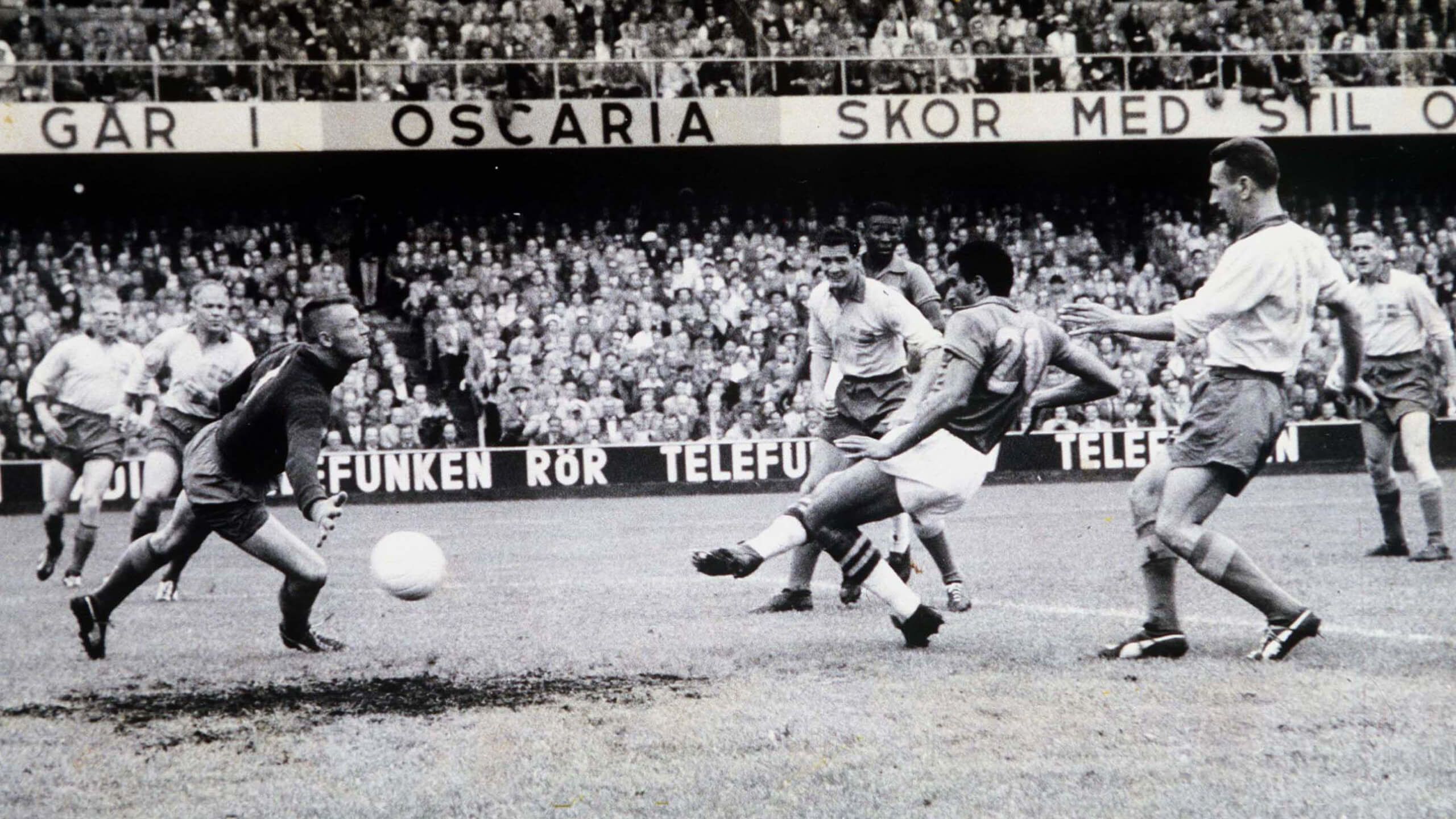
An injury in Brazil's second match ruled Pele out for the remainder of the tournament, but they responded superbly, topping their group before beating England and hosts Chile to reach the final.
There they met Czechoslovakia, with whom they had drawn 0-0 in the game that had cost them Pele.
It was a familiar story for Brazil in the final as they fell behind at the Estadio Nacional in Santiago courtesy of Josef Masopust's goal.
They would trail for only two minutes, though, with Amarildo levelling. Second-half goals from Zito and Vava gave them victory.

An emotional Mario Zagalo is helped from the field as Brazil celebrate victory in the 1962 World Cup final
An emotional Mario Zagalo is helped from the field as Brazil celebrate victory in the 1962 World Cup final
Brazil had matched Italy's achievement of the 1930s by winning back-to-back World Cups. No side has done it since.

And so we come to 1966...
The 1966 World Cup final is engraved into the psyche of every England fan, one against which all other performances by the Three Lions at major tournaments are measured.
It was played at Wembley in front of a crowd of 96,924 and the television viewing figures peaked at 32.3m, still the most watched TV broadcast in UK history. Not even Den serving Angie divorce papers on EastEnders on Christmas Day 1986 could beat it.
Things didn't start well for England in the final, with Helmut Haller giving West Germany a 12th-minute lead.
Geoff Hurst would begin the process of becoming a national hero by equalising with a header from a free-kick.
With 12 minutes to go Martin Peters thought he had given England victory with a strike to make it 2-1, but in the final minute Wolfgang Weber capitalised on a scramble in the England box following a free-kick to send the game to extra time.
England's third goal - and Hurst's second - remains controversial to this day. The West Ham forward's shot on the turn cannoned off the underside of the crossbar and bounced on the goalline. Was it over or not? Linesman Tofiq Bahramov believed it was...






"And here comes Hurst. He's got... Some people are on the pitch. They think it's all over. It is now! It's four!"
Kenneth Wolstenholme on the BBC described the goal that sealed Hurst's hat-trick and gave England their one and only World Cup triumph.
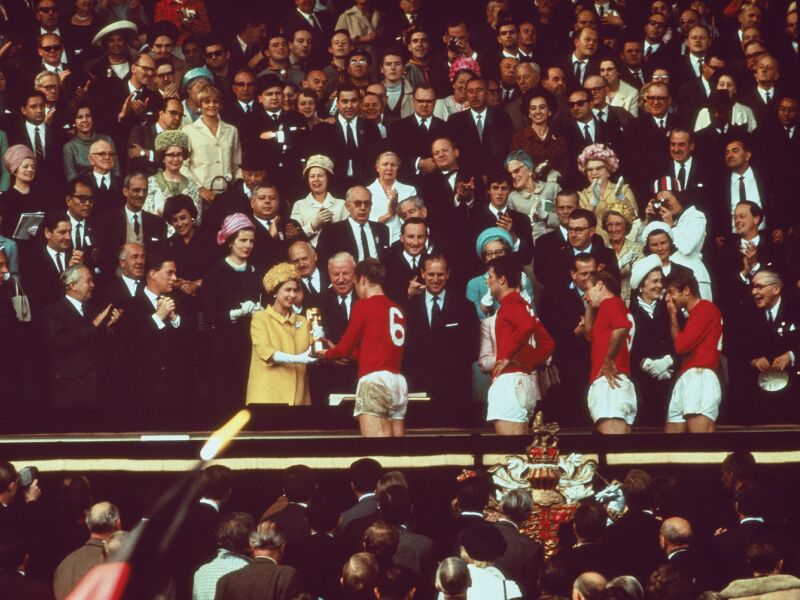
Queen Elizabeth II hands over the Jules Rimet trophy to Bobby Moore in 1966
Queen Elizabeth II hands over the Jules Rimet trophy to Bobby Moore in 1966
Below are the men who delivered England their first World Cup trophy.
Top row (left to right): trainer Harold Shepherdson, Nobby Stiles, Roger Hunt, Gordon Banks, Jack Charlton, George Cohen, Ray Wilson, manager Alf Ramsey. Bottom row: Martin Peters, Geoff Hurst, captain Bobby Moore, Alan Ball, Bobby Charlton.

Arguably, England had a stronger side in 1970 when they travelled to Mexico to defend the title.
But West Germany would get their revenge, knocking England out in the quarter-finals.
In truth, there was only one outstanding side in 1970 and it was the brilliant Brazil.
In the first World Cup to be transmitted in Technicolor across the globe, Brazil brought a vibrancy and colour previously unseen by most of the world, fronted by Pele, Jairzinho, Rivellino and Carlos Alberto.
In the final they faced Italy at the Estadio Azteca and immediately got into their stride, Pele leaping to head in the opener.
Roberto Boninsegna equalised following a defensive error, but Brazil were not to be denied, Gerson and Jairzinho making it 3-1 and putting them in total control.

Brazil's Jairzinho celebrates after walking the ball into the net for his side's third goal in the 1970 World Cup final
Brazil's Jairzinho celebrates after walking the ball into the net for his side's third goal in the 1970 World Cup final
There was still time for their pièce de resistance - a wonderful team goal spanning the length of the field, set up Pele and lashed home by captain Alberto.

Brazil players celebrate during the 1970 World Cup final
Brazil players celebrate during the 1970 World Cup final
It was a beautiful goal from a beautiful team. It gave Brazil an unprecedented third World Cup and the Jules Rimet Trophy for keeps.
At the end of the game Pele and his team-mates had shirts, shorts and boots torn from them as delirious fans flocked to celebrate.

Pele is held aloft by supporters after the 1970 World Cup final
Pele is held aloft by supporters after the 1970 World Cup final
The World Cup would switch back to Europe for the following tournament and a final showcasing another exponent of the beautiful game...

The Netherlands dazzled the world in 1974 with their brand of 'Total Football', a system in which any outfield player could fill the role of another in the team. Their talisman was Johan Cruyff, who had come through the Ajax academy and was then playing at Barcelona.

Johan Cruyff in 1974
Johan Cruyff in 1974
The Dutch looked to be making good on their promise when they took a second-minute lead in the final in Munich against hosts West Germany, Cruyff winning a penalty - the first awarded in a World Cup final - that Johan Neeskens fired home.
West Germany were a fine side themselves, led by captain and defender Franz Beckenbauer, with the prolific Gerd Muller in attack.
Paul Breitner equalised - also from the penalty spot - before Muller fired them ahead just before half-time. It would stay that way as West Germany added the World Cup to the European Championship title they won in 1972.
However, the Netherlands would be back...
Back, but once again beaten.
Without the retired Cruyff, the Netherlands reached the final in 1978, where they again met the hosts - this time Argentina.
In a bad-tempered game played out in front of a hostile crowd at the Estadio Monumental in Buenos Aires, Argentina rose to the occasion.
Mario Kempes struck in the 38th minute, but this was cancelled out by Dick Nanninga's second-half header.
In extra time Kempes struck again, officially getting the last touch during a scramble near the Netherlands goal. Daniel Bertoni sealed the game and trophy, slotting in with five minutes to go.
The final of 1982 brought together two of Europe's heavyweights - Italy and West Germany - at the Santiago Bernabeu in Madrid, Spain.

Alessandro Altobelli of Italy pushes his face into the chest of Uli Stielike of West Germany in the final of the 1982 World Cup
Alessandro Altobelli of Italy pushes his face into the chest of Uli Stielike of West Germany in the final of the 1982 World Cup
After a goalless first half, during which Italy's Antonio Cabrini fired a penalty wide, the game came to life.
Paolo Rossi, who would end the tournament as top scorer, broke the deadlock with his sixth goal (first picture below).
Marco Tardelli fired in Italy's second, sparking one of the most famous celebrations in World Cup history as he charged across the field screaming, shaking his head and pumping his fists.

Marco Tardelli celebrates scoring for Italy in the 1982 World Cup final
Marco Tardelli celebrates scoring for Italy in the 1982 World Cup final
Alessandro Altobelli made sure of Italy's victory before Paul Breitner netted a late consolation for West Germany.
It gave Italy their first World Cup triumph in 44 years and took them level with Brazil with three victories.
One man dominated the 1986 World Cup: Diego Armando Maradona.
The little wizard had already seen off England in the quarter-finals, through both foul and fantastic means, and the final - the second to be played at Mexico's wonderful Azteca Stadium - saw him and his Argentina side take on West Germany.

Diego Maradona of Argentina goes flying over the challenges of West German goalkeeper Harald Schumacher and defender Karl Heinz Foerster during the 1986 World Cup final
Diego Maradona of Argentina goes flying over the challenges of West German goalkeeper Harald Schumacher and defender Karl Heinz Foerster during the 1986 World Cup final
Heavily marked by Lothar Matthaus throughout, Maradona's influence on a gripping contest was limited but ultimately decisive.
Argentina took the lead through Jose Luis Brown, which was doubled just before the hour mark by Jorge Valdano.
West Germany refused to lie down and, with 16 minutes remaining, pulled one back through captain Karl-Heinz Rummenigge. Shortly after, Rudi Voller levelled the contest to set up the prospect of extra time.
It never came, though, with Maradona finding space to thread a superb pass for Jorge Burruchaga to score the winner with six minutes left.
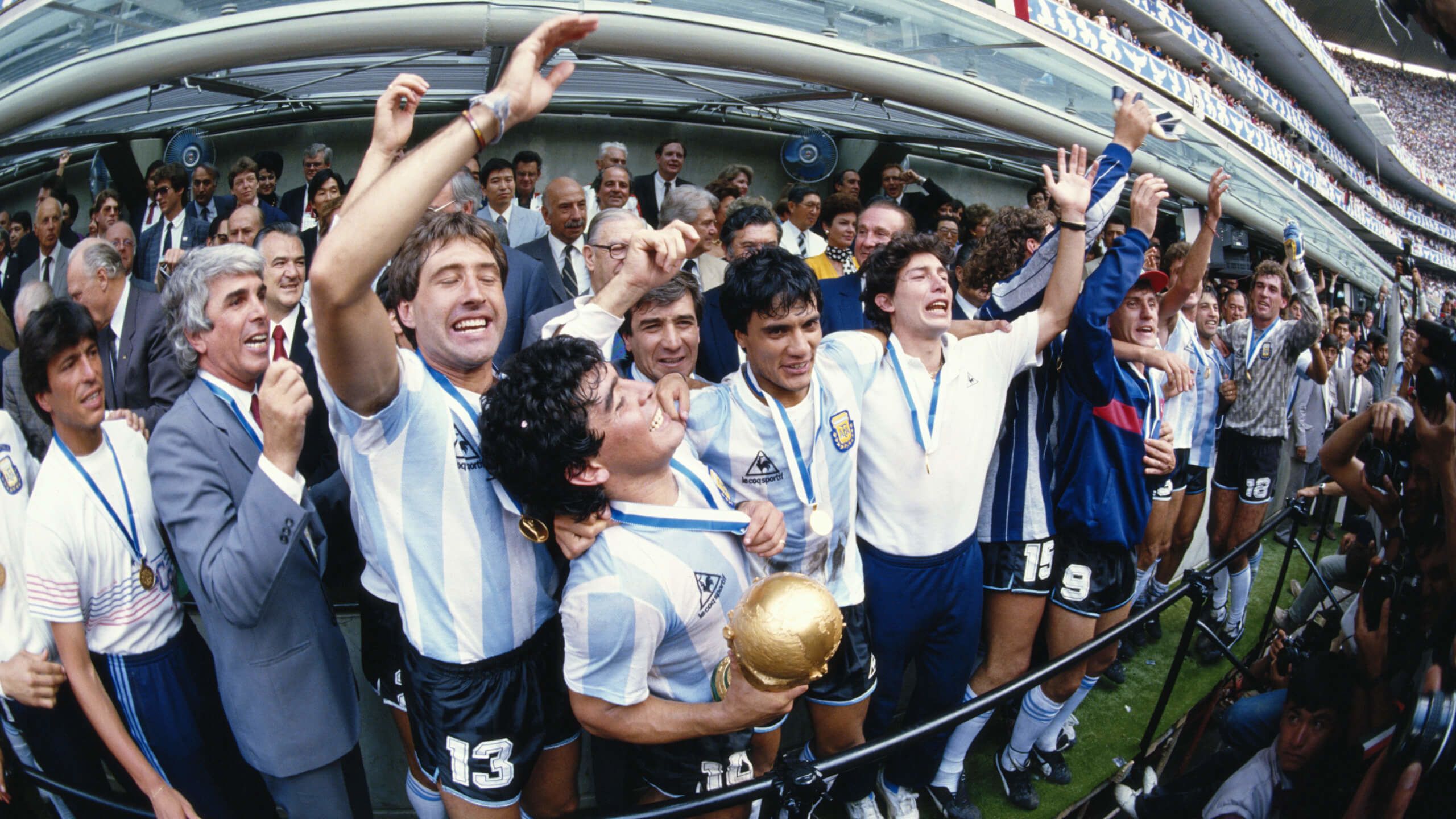
Football has a strange and compelling way of providing high-profile opportunities for revenge.
In 1990 the fates conspired to give West Germany their moment against Argentina and Maradona in Rome, Italy.
At the end of a culturally resonant tournament featuring Nessun Dorma, Big Jack's brave Repubic of Ireland, Roger Milla and Cameroon, Salvatore Schillaci and England penalty heartache, a single Andres Brehme kick settled the whole thing.

Andreas Brehme scores the winning penalty in the 1990 World Cup final
Andreas Brehme scores the winning penalty in the 1990 World Cup final
His penalty with five minutes to go gave West Germany a sweet victory.
This was not before two Argentina players were sent off during a violent contest. Pedro Monzon became the first player to be shown a red card in a World Cup final for a reckless challenge on Jurgen Klinsmann, and Gustavo Dezotti followed later for a second yellow.

Diego Maradona in tears at the end of the 1990 World Cup final
Diego Maradona in tears at the end of the 1990 World Cup final
It left Maradona in tears and West Germany celebrating a third World Cup to take them level with Brazil and Italy.

The World Cup broke new ground in 1994, moving away from Europe and South America as the USA became hosts.
The tournament would start and end with a penalty miss - singer Diana Ross' dragged spot-kick in the opening ceremony followed by Roberto Baggio firing his crucial kick over the bar in the World Cup final's first shootout.
A largely drab final at the Rose Bowl in Pasadena, California, ended 0-0 after 120 minutes, leaving the tournament to be decided in the most dramatic of ways.
Both teams missed their first penalty, followed by two successful kicks each. When Daniele Massaro failed for Italy and Dunga netted for Brazil, it left Baggio having to score.
The Juventus forward, 'Il Divin Codino' (The Divine Ponytail) was Italy's star, his performances and goals playing a major part in their reaching the final. His penalty was an awful one, though - way over the bar.
It gave Brazil their fourth World Cup and made them the tournament's most decorated nation.

Brazil players celebrate winning the 1994 World Cup
Brazil players celebrate winning the 1994 World Cup
They would be back in the final in 1998, but this time they met a force even they were powerless to resist.
It did not help Brazil's cause that they went into the showdown with hosts France in Paris with only a half-fit Ronaldo.
The forward was Brazil's talisman, a superstar capable of winning games on his own with his speed, strength and prowess in front of goal.
He was initially left off the Brazil teamsheet after suffering a convulsive fit before the game, but was added to it just before kick-off. His ineffectiveness in the final laid bare the fact he was unfit to play.

Fabian Barthez dives over Ronaldo in the final of the 1998 World Cup
Fabian Barthez dives over Ronaldo in the final of the 1998 World Cup
France had momentum behind them, as well as a passionate home crowd. They also had a star turn of their own in Zinedine Zidane.
He would take the game away from Brazil, heading in twice from corners.
Emmanuel Petit's stoppage-time finish added the icing for France and gave football a maiden World Cup winner for the first time in 20 years.
Ronaldo was not done yet, though.
He and Brazil bounced back in emphatic fashion four years later in the first World Cup held in Asia as Japan and South Korea shared hosting duties.
Germany were the opponents in the 2002 final, having sneaked past a trio of sides 1-0 in the knockout rounds.
A goalless first half suggested another tight contest, but after the break Ronaldo burst into life.
His first goal was a follow-up to a saved Rivaldo effort, his second a low shot past Oliver Kahn. They were his seventh and eighth goals of the tournament. Nobody could match him.

Rivaldo, Ronaldo and Gilberto Silva with the World Cup trophy in 2002
Rivaldo, Ronaldo and Gilberto Silva with the World Cup trophy in 2002
It meant a fifth World Cup victory for Brazil, with the Selecao now victorious on four continents.

Zidane was France's hero in 1998, but eight years later in Germany he was the villain.
It didn't appear to be going that way when he cheekily chipped in a Panenka penalty to give them the lead against Italy in Berlin's Olympiastadion.
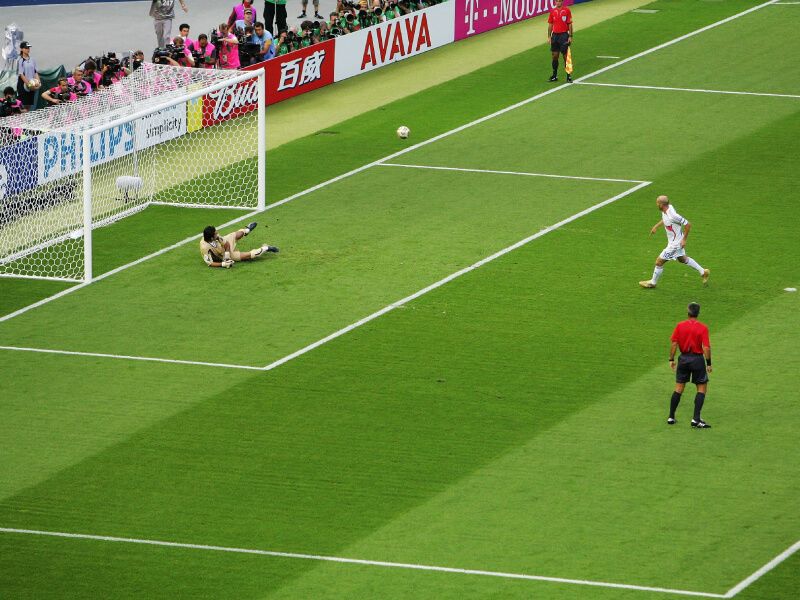
Zinedine Zidane scores a penalty in the final of the 2006 World Cup
Zinedine Zidane scores a penalty in the final of the 2006 World Cup
Having given away that penalty, Marco Materazzi made amends, heading Italy level from an Andrea Pirlo corner. The defender's high-profile involvement in the game was not over yet, though.
In an off-the-ball incident in extra time Zidane headbutted Materazzi in the chest...

Zinedine Zidane headbutts Marco Materazzi in the final of the 2006 World Cup
Zinedine Zidane headbutts Marco Materazzi in the final of the 2006 World Cup
...and was sent off.

Zinedine Zidane walks past the World Cup trophy after being sent off in the final in 2006
Zinedine Zidane walks past the World Cup trophy after being sent off in the final in 2006
France were able to hold on with 10 men for the remaining 10 minutes to take the game to penalties. But without one of their main penalty takers, France were unable to match Italy, who scored all five of their kicks to ensure victory after David Trezeguet's miss.

Italy captain Fabio Cannavaro lifts the World Cup aloft following victory on penalties in the 2006 final
Italy captain Fabio Cannavaro lifts the World Cup aloft following victory on penalties in the 2006 final
The World Cup entered new territory again in 2010, with South Africa becoming the first African hosts.
It would witness the crowning moment of one of modern football's great sides...

Spain arrived at the 2010 World Cup as European champions and with a squad packed with talent, the core of which came from Barcelona and Real Madrid.
They were the standout side at the tournament and made good on their promise. They had to overcome a stubborn and physically tough Netherlands team in Johannesburg's Soccer City to do so.

Nigel de Jong plants his boot into the chest of Xabi Alonso in the final of the 2010 World Cup
Nigel de Jong plants his boot into the chest of Xabi Alonso in the final of the 2010 World Cup
After a goalless 90 minutes, the Netherlands were reduced to 10 men in the 109th minute when John Heitinga was shown a second yellow card for a foul on Andres Iniesta.

John Heintinga is sent off in the final of the 2010 World Cup
John Heintinga is sent off in the final of the 2010 World Cup
There was no stopping Iniesta seven minutes later when he drove a shot past Maarten Stekelenburg to give Spain their first World Cup.
They would retain their European crown two years later to underline their international dominance.
In Brazil in 2014, though, a familiar name rose to the top again...
Germany had already stunned the hosts - and the world - by beating Brazil 7-1 in the semi-finals of the 2014 tournament.
The final brought them up against their old nemesis from 1986 and 1990, Argentina.
For the second tournament running a single goal in extra time decided the contest, with Mario Gotze netting to give Germany a fourth World Cup.
Four years later the 2018 tournament in Russia saw a meeting between France and first-time finalists Croatia at the Luzhniki Stadium in Moscow.

Ivan Perisic scores for Croatia in the final of the 2018 World Cup
Ivan Perisic scores for Croatia in the final of the 2018 World Cup
In front of a crowd of 78,011 and an estimated global television audience of 1.12bn, Mario Mandzukic's own goal put France ahead before Ivan Perisic levelled.
The 1998 winners then seized control, with an Antoine Griezmann first-half penalty and goals from Paul Pogba and Kylian Mbappe after the break ending the Croatia challenge.

Keeper Danijel Subasic lies on his back in the Croatia goal after France score in the 2018 World Cup final
Keeper Danijel Subasic lies on his back in the Croatia goal after France score in the 2018 World Cup final
Although Mandzukic scored a late consolation, by that point the trophy was heading back to France.

French president Emmanuel Macron celebrates France scoring in the 2018 World Cup final
French president Emmanuel Macron celebrates France scoring in the 2018 World Cup final
And so to Sunday and the 2022 World Cup final, when France and Argentina will add to the list of famous images from World Cup finals...

Credits
Written and produced by Phil Dawkes
Pictures supplied by Getty Images
Getty contributors: Allsport UK, Bongarts, Shaun Botterill, Clive Brunskill, Mario Carrieri, Cattani, Laurence Griffiths, Haynes Archive, Mike Hewitt, Hulton Archive, Mike King, Alex Livesey, Clive Mason, Jamie McDonald, Steve Munday, Popperfoto, Mike Powell, Steve Powell, Bob Thomas, Ben Radford, Rolls Press, Mark Sandten, Billy Stickland, Henri Szwarc, Toni Triolo, VI Images
Sub-edited by Justin Goulding
